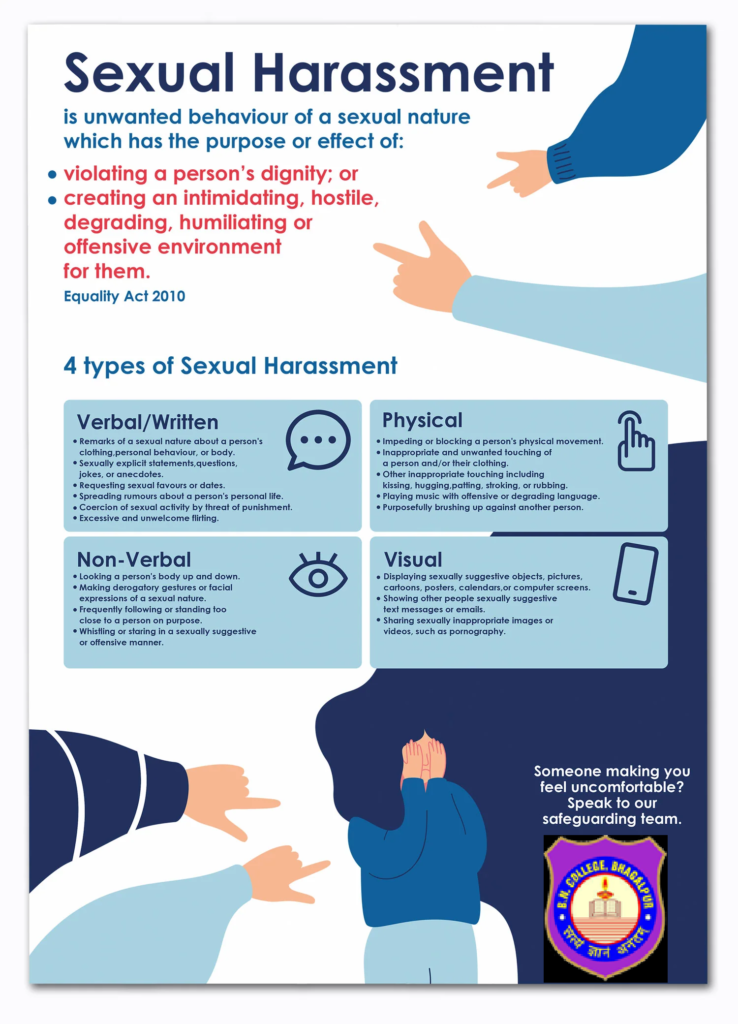The Sexual Harassment of Women at Workplace (Prevention, Prohibition and Redressal) Act, 2013 is a legislative act in India that seeks to protect women from sexual harassment at their place of work. (From Wikipedia, the free encyclopedia)
Preventing sexual harassment in colleges requires a concerted effort from college administrations, government bodies, students, and faculty. Here’s how colleges in India can work towards preventing sexual harassment:
- Compliance with Legal Requirements: Ensure compliance with the Sexual Harassment of Women at Workplace (Prevention, Prohibition, and Redressal) Act, 2013, which mandates the establishment of Internal Complaints Committees (ICCs) in educational institutions.
- Development and Implementation of Policies: Formulate and implement comprehensive policies and guidelines specifically addressing sexual harassment. These policies should include definitions, reporting procedures, investigation processes, and disciplinary actions.
- Awareness and Training Programs: Conduct regular awareness sessions and training programs for students, faculty, and staff to educate them about sexual harassment, its forms, consequences, and prevention strategies. Training should also cover the role and functioning of ICCs.
- Establishment of Internal Complaints Committees (ICCs): Set up ICCs comprising faculty, staff, and student representatives trained in handling sexual harassment complaints. Ensure that ICC members are sensitive, impartial, and equipped to conduct fair investigations.
- Confidential Reporting Mechanisms: Provide multiple channels for reporting sexual harassment, including confidential options. Ensure that victims feel safe and supported when reporting incidents and protect their privacy throughout the process.
- Support Services: Offer support services such as counseling, legal assistance, and medical support to survivors of sexual harassment. Collaborate with external organizations and NGOs to provide comprehensive support.
- Promotion of Gender Sensitivity and Equality: Foster a culture of gender sensitivity and equality within the college community through seminars, workshops, and campaigns. Encourage respectful behavior and challenge stereotypes and attitudes that perpetuate harassment.
- Regular Review and Monitoring: Periodically review and assess the effectiveness of prevention measures through feedback mechanisms, surveys, and audits. Make necessary revisions to policies and procedures based on the findings.
- Inclusion of Anti-Sexual Harassment Measures in Curricula: Incorporate discussions on sexual harassment, gender equality, and consent into the curriculum across disciplines to promote awareness and understanding among students.
- Collaboration with External Stakeholders: Collaborate with government bodies, NGOs, legal experts, and law enforcement agencies to strengthen prevention efforts and ensure timely redressal of complaints.
- Promotion of Bystander Intervention: Encourage bystander intervention by educating students and faculty on how to recognize and safely intervene in situations of potential harassment.
- Promotion of Gender-Neutral Spaces: Create gender-neutral spaces on campus and ensure that all facilities are accessible and safe for everyone, regardless of gender identity.
By implementing these measures, colleges can create safer environments where students, faculty, and staff can learn, work, and thrive without fear of sexual harassment.


